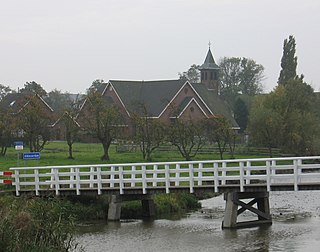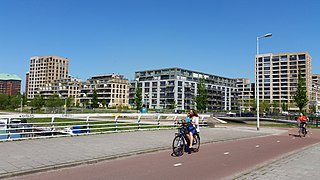History
Slotermeer is part of a larger neighborhood called Westelijke Tuinsteden. Following the creation of the Algemeen Uitbreidingsplan in 1935, the first outline for the Slotermeer neighbourhood was drawn up in 1939. The Slootermeer Lake was drained in 1644. This formed the Sloterdijkermeerpolder (a polder), which was excavated into the Sloterplas between 1948 and 1956.
Garden village
In November 1927, the municipality of Amsterdam decided that the land west of the Ringspoorbaan would primarily be used for single-family houses. The housing department was tasked to work out a plan in cooperation with Public works for the construction of an area of about 400 hectares. The garden village would be built in the same style as other garden villages that were built around that time, such as Betondorp, Nieuwendam and Tuindorp Oostzaan. Discussions between the housing department and Public works fell flat and the plan was abandoned.
However, they did keep discussing about a small triangular section of 23 hectares between the Ringspoorbaan, the Haarlemmerweg and the unrealised connection to the Haarlem railway. This downscaled plan envisaged strokenbouw (construction in parallel rows), in the same vein as the ‘Neue Sachlichkeit’ of the new neighborhoods built in Frankfurt am Main in the 1920s. Again, this plan was abandoned as well due to disagreements and it was decided to wait for the Algemeen Uitbreidingsplan first.
Garden city
As a result of World War II, the construction of Slotermeer was delayed by more than a decade. Construction began on 1 December 1951, and in late 1952, the first houses were ready to be lived in. On 7 October 1952, the first Garden City of Amsterdam outside the Ringspoorbaan was officially opened by Queen Juliana.
A part of Slotermeer was declared protected townscape by the District Council in 2007, namely the Van Eesteren Museum, a museum dedicated to Cornelis van Eesteren. Nevertheless, in 2009 it was decided to proceed with large-scale demolition in the northern and southern part of Slotermeer as part of urban renewal.
Location and surroundings
Slotermeer is bordered to the north by the Haarlemmerweg and to the south by the Sloterplas (a lake) and Sloterpark, as well as Sportpark Ookmeer. The eastern boundary is the Ringspoorbaan, the western boundary the Eendrachtspark and Geuzeneiland (a small island). At the heart of the neighbourhood is the Gerbrandypark.
The neighbourhood consists of a mixture of low, medium, and high-rise buildings and was fully built up by the mid-1960s. Many streets are named after World War II resistance fighters, mayors of Amsterdam and Dutch writers from the nineteenth and early twentieth centuries. Plein '40-'45 (the town square) and the south side of the Burgemeester de Vlugtlaan and the west side of the Slotermeerlaan form the centre of the neighbourhood, featuring an indoor mall, shops, a local market, the Vrijheids carillon, the Garden City House (an office building), hotels, offices and a small harbour.
The first few years, Slotermeer had a tram connection to the city centre with a stop along the Amsterdam - Zandvoort tram network. On 1 September 1957, the tram was replaced by a bus service. In September 1954, tramway 13 was the first Amsterdam tramway to be extended beyond the Ringspoor dyke from Bos en Lommerplein to Slotermeer. The tram got its last stop at the end of the Slotermeerlaan (an avenue), near Sloterpark. In 1974, tramway 13 was extended to Geuzenveld and the last section to Sloterplas was cancelled. In 1989, tramway 13 was relocated to the new route via the Jan van Galenstraat - Burgemeester Röellstraat. The old route then became part of tramway 14, until 22 July 2018 when tramway 14 was cancelled. Since 2004, tramway 7 has also been added.
When stadsdelen (borough) were established in 1990, the neighbourhood became part of Geuzenveld-Slotermeer. Since 2010, it has been part of the stadsdeel Amsterdam Nieuw-West.

Amsterdam is the capital and most populated city of the Netherlands. It has a population of 921,402 within the city proper, 1,457,018 in the urban area and 2,480,394 in the metropolitan area. Located in the Dutch province of North Holland, Amsterdam is colloquially referred to as the "Venice of the North", for its large number of canals, now a UNESCO World Heritage Site.

Alblasserdam is a town and municipality in the western Netherlands, in the province of South Holland. It covers an area of 10.06 km2 (3.88 sq mi), of which 1.28 km2 (0.49 sq mi) is water, and has a population of 20,136 as of 2021. Alblasserdam is officially a part of the Drechtsteden region. A portion of the small village of Kinderdijk, which boasts the largest and most famous concentration of windmills in the Netherlands, is part of Alblasserdam.

The Amsterdam Metro is a rapid transit system serving Amsterdam, Netherlands, and extending to the surrounding municipalities of Diemen and Ouder-Amstel. Until 2019, it also served the municipality of Amstelveen, but this route was closed and converted into a tram line. The network is owned by the City of Amsterdam and operated by municipal public transport company Gemeente Vervoerbedrijf (GVB), which also operates trams, free ferries and local buses.

Pieter Lodewijk (Piet) Kramer was a Dutch architect, one of the most important architects of the Amsterdam School.

IJburg is a residential neighbourhood under construction in Amsterdam, Netherlands. It is situated in the IJmeer and is being built on artificial islands which have been raised from the lake. The Haveneiland, Rieteilanden, Steigereiland and Centrumeiland are already inhabited as of 2004. It is part of the municipality Amsterdam-Oost and also contains the Diemerpark, one of the city's largest parks.

The Amsterdam Tram is a tram network in Amsterdam, Netherlands. It dates back to 1875 and since 1943 has been operated by municipal public transport operator Gemeentelijk Vervoerbedrijf (GVB), which also runs the Amsterdam Metro and the city bus and ferry services. Amsterdam has the largest tram network in the Netherlands and one of the largest in Europe.

The Netherlands Architecture Institute (NAI) was a cultural institute for architecture and urban development, which comprised a museum, an archive plus library and a platform for lectures and debates. The NAI was established in 1988 and was based in Rotterdam since 1993. It ceased to exist in 2013, when it became part of Het Nieuwe Instituut.
The Dutch city of Amsterdam has had many planned expansions over the past two centuries.

The Westerpark is a public urban park in Amsterdam, Netherlands. The former borough (stadsdeel) of Westerpark is named after the park, as is the current neighborhood.

Amsterdam Nieuw-West is a borough comprising the westernmost neighbourhoods of the city of Amsterdam, Netherlands. It was created in 2010 after a merger of the former boroughs Osdorp, Geuzenveld-Slotermeer and Slotervaart. In 2017, the borough had almost 150,000 inhabitants.

Dapperbuurt is a neighbourhood located in the east of Amsterdam, Netherlands. It is demarcated by the Oosterpark and Linnaeusstraat, Mauritskade, and the railway, Oosterspoor, including station Amsterdam Muiderpoort. The heart of this lively, multicultural neighbourhood is its daily market, the Dappermarkt. There are various shops, restaurants, religious and cultural centres, schools and services, while bordering the neighbourhood is the Wereldmuseum Amsterdam.

De Baarsjes is a district in Amsterdam-West situated west of the city center of Amsterdam, Netherlands. Named after a former hamlet, urban development started in the 1920s. It contains the neighbourhoods Admiralenbuurt, Chassébuurt, Postjesbuurt, and Trompbuurt.
The Molenwijk district is a neighborhood in Amsterdam-Noord in the Dutch province of North Holland. It is part of the Oostzanerwerf district.

Rivierenbuurt is a neighbourhood of Amsterdam, Netherlands. The neighbourhood is situated in the eastern part of the borough of Amsterdam-Zuid, bordered by the river Amstel to the east, the Boerenwetering canal in the west, the Amstelkanaal in the north and the A10 motorway in the south. In 2013, the Rivierenbuurt had approximately 28,400 residents.

The Papaverhof is a housing complex in The Hague that was designed by Jan Wils. Built between 1919 and 1921, the project was Wils' breakthrough as an architect. Today the Papaverhof is a Rijksmonument that is one of the Top 100 Dutch heritage sites. The complex was restored in 1958, 1971, 1989, and 2006.

The Maupoleum (1971–1994) was a building on Amsterdam's Jodenbreestraat. Built in 1971, it acquired a reputation for being unattractive before being demolished in 1994.

Rembrandtpark is an urban park in Nieuw-West, Amsterdam, Netherlands. The park is named after the 17th-century painter Rembrandt. The park was completed in 1973 and has a surface area of 45 hectares which includes a petting zoo and playgrounds.

The Berlagebrug is a bascule bridge over the river Amstel in Amsterdam, Netherlands. The bridge was commissioned by the Amsterdam municipality and designed by engineer Cornelis Biemond (1899-1980) and architect Hendrikus Petrus Berlage (1856–1934); it was named after the latter. It was constructed from 1926 to 1931 and officially opened on 28 May 1932. It has been designated as a Rijksmonument since 11 May 2008. The bridgekeeper's house carries the address Amsteldijk 134.
The following is an alphabetical list of articles related to Amsterdam. Amsterdam is the capital city of the Netherlands.
















